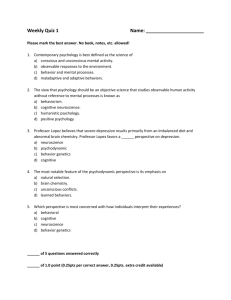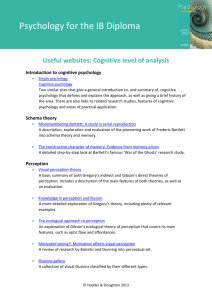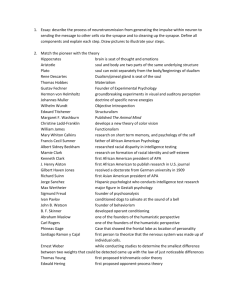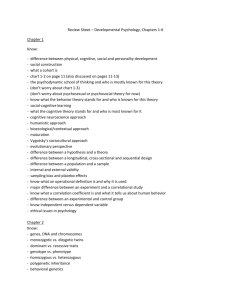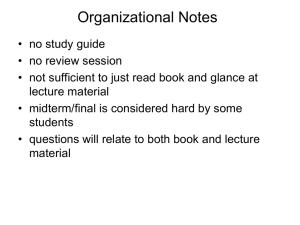PSYC3316 - The University of Western Australia
advertisement
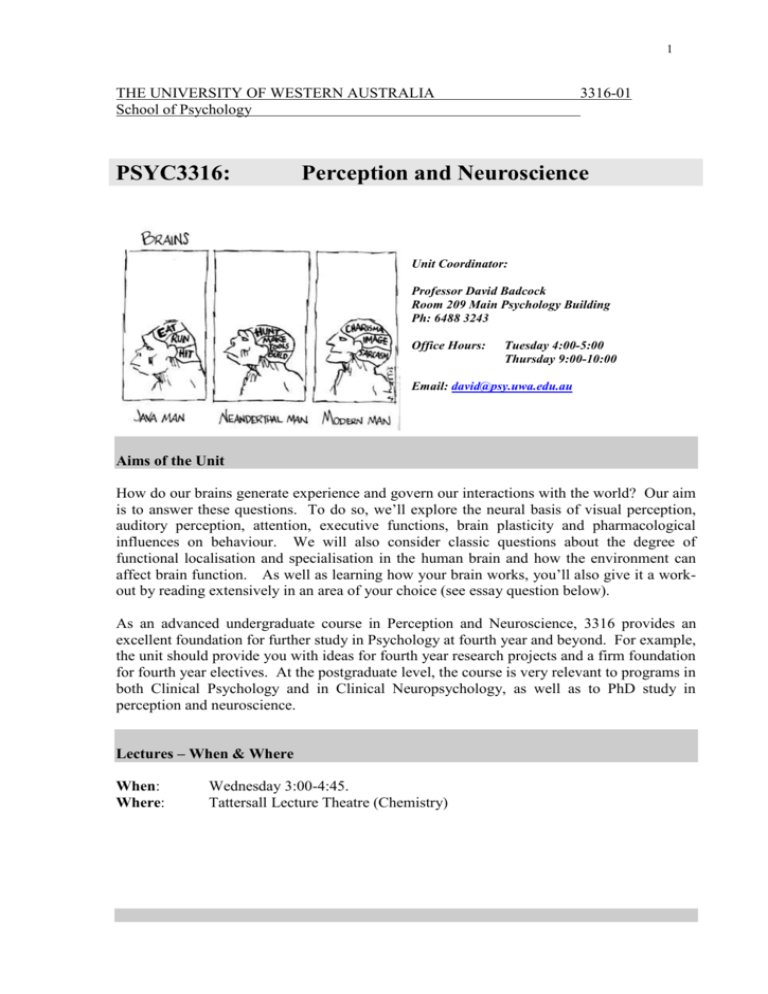
1 THE UNIVERSITY OF WESTERN AUSTRALIA School of Psychology PSYC3316: 3316-01 Perception and Neuroscience Unit Coordinator: Professor David Badcock Room 209 Main Psychology Building Ph: 6488 3243 Office Hours: Tuesday 4:00-5:00 Thursday 9:00-10:00 Email: david@psy.uwa.edu.au Aims of the Unit How do our brains generate experience and govern our interactions with the world? Our aim is to answer these questions. To do so, we’ll explore the neural basis of visual perception, auditory perception, attention, executive functions, brain plasticity and pharmacological influences on behaviour. We will also consider classic questions about the degree of functional localisation and specialisation in the human brain and how the environment can affect brain function. As well as learning how your brain works, you’ll also give it a workout by reading extensively in an area of your choice (see essay question below). As an advanced undergraduate course in Perception and Neuroscience, 3316 provides an excellent foundation for further study in Psychology at fourth year and beyond. For example, the unit should provide you with ideas for fourth year research projects and a firm foundation for fourth year electives. At the postgraduate level, the course is very relevant to programs in both Clinical Psychology and in Clinical Neuropsychology, as well as to PhD study in perception and neuroscience. Lectures – When & Where When: Where: Wednesday 3:00-4:45. Tattersall Lecture Theatre (Chemistry) 2 316 Lecturers (DV) Dr David Van Valkenburg, (DB) Prof David Badcock, (AF) Dr Allison Fox, (GH) Prof Geoff Hammond WEEK LECTURE TOPIC & REQUIRED READINGS Page numbers are for 4th ed of Rosenzweig et al unless otherwise stated (see below for information on text and reading packet) 1 Functional localization in the Human Cortex: Logic and techniques STAFF DB Text Ch 10. Gregory, R. L. (1974). Concepts and mechanisms of perception. Chapter 49 The brain as an engineering problem. Duckworth, London, pp 547-565 Savoy, R. L. (2001). History and future directions of human brain mapping and functional neuroimaging. Acta Psychologica, 107(1-3), 9-42. 2 Functional localization in the Human Cortex: behavioural techniques. The role of the early visual pathways in visual disorders DB Text Ch 10. pp 294-310. Gazzaniga et al Ch5 pp153-163 Vidyasagar, T. R. (2004). Neural underpinnings of dyslexia as a disorder of visuo-spatial attention. Clinical and Experimental Optometry, 87(1), 4-10. McKendrick, A. M., & Badcock, D. R. (2003). Contrast-Processing Dysfunction in both Magnocellular and Parvocellular Pathways in Migraineurs with or without Aura. Invest. Ophthalmol. Vis. Sci., 44(1), 442-448. McKendrick, A. M., Vingrys, A. J., Badcock, D. R., & Heywood, J. T. (2001). Visual dysfunction between migraine events. Invest. Ophthalmol. Vis. Sci.,42, 626-633. Cortical processing of visual input: phenomenal vision and Blindsight Text Ch.10 Cowey, A. (2004). The 30th Sir Frederick Bartlett lecture: Fact, artefact, and myth about blindsight. The Quarterly Journal of Experimental Psychology, 57A(4), 577–609. Persaud, N., McLeod, P. & Cowey, A. Post-decision wagering objectively measures awareness. Nature Neuroscience. 10, 257-261 (2007). 3 Functional streams in the visual system: the motion stream and the coding of space DB Text Ch 10. pp. 314-316. Gazzaniga et al. Ch 5 pp175-177 [1st ed, Ch 4 pp 142-144 and 146-147] Goldstein (5th ed) pp. 105- 113 and 294-300. 4 Color vision, colour blindness and the impact of cortical lesions Text Ch 10. pp 310-314. Gazzaniga et al. Ch 5 pp153-163 and 172-175 Goldstein, E.B. Sensation and Perception (5th ed), ch. 5 or (6th ed) ch. 6. Tranel, D. (2001) Central color processing and its disorders. In Behrman,M (Ed) Handbook of Neuropsychology: 4. Disorders of Visual Behaviour, pp. 1-14. DB 3 5 Neural pathways, cortical function, cortical deficits in audition DV Background Reading (from 201): Sekuler and Blake Ch 10, 11. Rosenzweig Ch 9 pgs 249-267;? Peretz, I. (1993) Auditory agnosia: a functional analysis (Ch 7). In McAdams, S. and Bigand, E. (Eds), Thinking in Sound: The Cognitive Psychology of Human Audition. Oxford University Press, pp. 199-230. DeWeese, M., Hromadka, T., and Zador, A. (2005). Reliability and Representational Bandwidth in the Auditory Cortex. Neuron, 48, 479-488. 6 7 8 9 10 Speech and music perception Blake and Sekuler: Perception (5th edition) (2005). Ch. 12, pgs 427-556. Zattore, R., Belin, P., and Penhume, V. (2002). Structure and function of auditory cortex: music and speech. Trends in Cognitive Sciences, 6(1), 37-46. Koelsch, S. and Siebel, W. (2005). Towards a neural basis of music perception. Trends in Cognitive Sciences, 9(12), 578-584. Attention and ERPs Text p 227-228 Zhang, P., Chen, X., Yuan, P., Zhang, D., & He, S. (2006). The effect of visuospatial attentional load on the processing of irrelevant acoustic distractors. Neuroimage, 33, 715-724. Psychopharmacology Text ch. 4 Cools, R., Lewis, S. J. G., Clark, L., Barker, R. A., & Robbins, T. W. (2007). LDOPA disrupts activity in the nucleus accumbens during reversal learning in Parkinson's Disease. Neuropsychopharmacology, 32, 180-189. Substance abuse Text ch. 4. Nixon, K. (2006). Alcohol and adult neurogenesis: Roles in neurodegeneration and recovery in chronic alcoholism. Hippocampus, 16, 287-295. Sullivan, E. V., Rosenbloom, M. J., Lim, K. O., & Pfefferbaum, A. (2000). Longitudinal changes in cognition, gait, and balance in abstinent and relapsed alcoholic men: Relationships to changes in brain structure. Neuropsychology, 14, 178-188. Cognitive reserve and aging. DV AF AF AF AF Richards, M., & Deary, I. J. (2005). A life course approach to cognitive reserve: A model for cognitive aging and development. Annals of Neurology, 58, 617-622. 11 Cognitive reserve and aging. AF Cabeza, R., Anderson, N. D., Locantore, J. K., & McIntosh, A. R. (2002). Aging gracefully: Compensatory brain activity in high-performing older adults. NeuroImage, 17, 1394-1402. Hedden, T., & Gabrieli, J. D. E. (2004). Insights into the ageing mind: A view from cognitive neuroscience. Nature Reviews Neuroscience, 5, 87-97. 12 The brain and voluntary movement. GH Rosenzweig et al. (2005). Biological Psychology (4th Ed.), Sunderland, MA: Sinauer. Chapter 11. Wolpert, D.M. & Flanagan, J.R. (2001) Motor prediction. Current Biology, 11, R729-R732. 13 Neural plasticity: motor cortex as a model system. Pascual-Leone, A., Amedi, A., Fregni, F., & Merabet, L.B. (2005) The plastic human brain cortex. Annual Review of Neuroscience, 28, 377–401. Rosenzweig et al. (2005). Biological Psychology (4th Ed.), Sunderland, MA: Sinauer. Chapter 18 (pp 553-569); Chapter 19 (pp(608-614); Afterword. GH 4 Laboratories Note: The laboratory programme will not be recorded and requires attendance to be of value. The first lab is intended to give you experience in designing a method for answering a specified question and then conducting the planned research. The lab report will involve people working in pairs on a project and both partners need to ensure they are available to ensure the first lab book report can be completed during weeks 2-4. Week Topic 2 Measuring Visual performance: preparation, design and data collection Measuring Visual performance: data collection Measuring Visual performance: data collection Executive Function No labs PROSH Wednesday Good Friday ERP recording No labs ANZAC Day Tuesday ERP recording 3 4 5 6 7 8 9 10 11 Assessment Lab Report Due Essay Due What you should read. Text: Rosenzweig, M.R., Leiman, A.L., & Breedlove. S.M. (2005). Biological Psychology (4th Ed.). Sunderland, MA: Sinauer. Still very useful: Gazzaniga, M.S., Ivry, R.B., & Mangun, G.R. (2002) Cognitive Neuroscience, 2nd ed. NY: W.W. Norton. [you can use the 1st ed, but 2nd is much better] Get your money’s worth! – review the following sections before the first class Rosenzweig et al (2005)Chapter 2 & 3. OR Gazzaniga et al (2002) Chapter 1 Gross and functional anatomy of the nervous system (Ch3) Methods - especially single cell recordings, lesions, single and double dissociations, PET and fMRI (Ch4) Reading Packet: This will be available from the main office in the first week of semester. It contains all the readings you need for the lectures (see table above) and to get started on your essay preparation (see below). The readings are in alphabetical order in the pack. ON RESERVE: Gazzaniga, M.S., Ivry, R.B., & Mangun, G.R. (2002) Cognitive Neuroscience, 2nd ed. NY: W.W. Norton. [you can use the 1st ed, but 2nd is much better] 5 Rosenzweig, M.R., Leiman, A.L., & Breedlove. S.M. (1999). Biological Psychology (4th Ed.). Sunderland, MA: Sinauer. What’s the Assessment? Exam: 60% of final grade Duration 2hrs. Format: Answer four questions from eight alternatives. Answer one of two questions from each lecturer Please NOTE: We believe that the ability to identify the main theme of a lecture is an important academic skill. The exam questions in 3316 will focus on the main themes of the lectures. In previous courses you have been given a list of possible questions to help you develop this skill. However, in 3316 it is time to determine how well you have learnt this ability. For this reason no list of possible questions will be provided but the exam will focus on the main themes within lectures. Essay: 20% of final grade Laboratory Report: 15% of final grade Laboratory Participation: 5% of final grade Due 9.00 am Monday May 7. Maximum length of 2500 words Due 9.00 am Monday April 2nd Max Length of 1500 words Note this requires active contribution-not just attendance. Essay questions: “Is it possible to determine whether functions are localised in the human cortex? Develop your arguments by focussing on EITHER motion perception OR auditory perception OR executive functions." Starter readings for essay: (We do expect you to add to this list with your own searches in the library). General Rosenzweig et al Ch 1& 2. Gazzaniga et al., Ch 1. Gregory, R. L. (1974). Concepts and mechanisms of perception. Chapter 49 The brain as an engineering problem. Duckworth, London, pp 547-565 Phillips, C. G, Zeki, S. & Barlow, H. B. (1984) Localisation of function in the cerebral cortex: past, present and future. Brain, 107, 327-361. Coltheart, M. (2004). 2004. Cognitive Neuropsychology, 21(1), 21-25. Savoy, R. L. (2001). History and future directions of human brain mapping and functional neuroimaging. Acta Psychologica, 107(1-3), 9-42. Savoy, R. L. (2005). Experimental design in brain activation MRI: Cautionary tales. Brain Research Bulletin, 67(5), 361-367. 6 Motion Perception Tootell, R. B., Dale, A. M., Sereno, M. I. & Malach, R. (1996) New images from human visual cortex. Trends in Neurosciences,19, 481-489. Badcock, D. R. & Khuu, S. K. (2001) Independent first- and second-order motion energy analyses of optic flow. Psychological Research, 65, 50-56 [The introduction of this article provides a summary of the regions involved in motion processing and also provides some references to papers discussing clinical disorders of motion processing]. Auditory Perception Peretz, I. (1993) Auditory agnosia: a functional analysis (Ch 7). In McAdams, S. and Bigand, E. (Eds), Thinking in Sound: The Cognitive Psychology of Human Audition. Oxford University Press, pp. 199-230. Executive Functions Mathalon, D. H., Whitfield, S. L., & Ford, J. M. (2003). Anatomy of an error: ERP and fMRI. Biological Psychology, 64, 119-141. van Veen, V., & Carter, C. S. (2002). The anterior cingulate as a conflict monitor: fMRI and ERP studies. Physiology & Behavior, 77, 477-482. What if I need an Extension? Requests for extensions of the submission deadlines for written work must be made to the appropriate year co-ordinator, not the unit co-ordinator, in which the extension is sought. Extensions will normally be granted only in instances where an unforeseeable and unavoidable event, such as illness, prevents the work from being submitted by the due date. Extensions to the deadline will not be granted for holidays, professional and sporting commitments, or clashing assignment deadlines. Extensions must be signed by the student and the year co-ordinator. Late assignments will be penalised by 5% of the available marks for each day after the published submission deadline. You should note that work submitted on the due day but after the submission time specified will be recorded as one day late. What if I have Questions? There are weekly labs or tutorials associated with the unit (week 2 to week 9), so please feel free to discuss matters with your laboratory tutors during those sessions. You may also direct questions about the material to the relevant lecturer and questions about the unit generally to the unit co-ordinator (David B). Plagiarism And Unfair Conduct Students are referred to the University policy on Ethical Scholarship, Academic Literacy and Academic Misconduct. It is important that you familiarize yourself with this policy as it may differ from your current understanding. It is posted on the web at http://www.teachingandlearning.uwa.edu.au/tl/academic_conduct Additional information to aid students in achieving an appropriate standard of academic literacy is provided in the School of Psychology Policy on Assignments, which is available as handout GE-00 at the front office or on the web under Information for Current Students. It also changed in 2005 and you should familiarize yourself with the new version. It will help you to understand what plagiarism is, and how to avoid it; all assignment coversheets including those for this unit will require you to sign to the effect that you have read and understood both the School of Psychology and the University policies. 7 Students have been penalised as described above in recent years, including 2000-2006. It is essential therefore that you ensure that your work is always your own. Talk to your tutor or unit coordinator if you are in doubt. It is particularly important that you are careful to avoid difficulties in the first laboratory book report. We do expect you to work in pairs when designing the method and during data collection but you will then write up the data reflecting your partner’s performance in the experiment and this write-up should be your individual work. “Information in this publication is correct as at February 23, 2007, but is subject to change from time to time. In particular, the University reserves the right the change the content and/or the method of presentation and/or the method of assessment of any unit of study, to withdraw any unit of study or program, and/or to vary arrangements for any program.”
